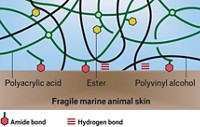Advertisement
Grab your lab coat. Let's get started
Welcome!
Welcome!
Create an account below to get 6 C&EN articles per month, receive newsletters and more - all free.
It seems this is your first time logging in online. Please enter the following information to continue.
As an ACS member you automatically get access to this site. All we need is few more details to create your reading experience.
Not you? Sign in with a different account.
Not you? Sign in with a different account.
ERROR 1
ERROR 1
ERROR 2
ERROR 2
ERROR 2
ERROR 2
ERROR 2
Password and Confirm password must match.
If you have an ACS member number, please enter it here so we can link this account to your membership. (optional)
ERROR 2
ACS values your privacy. By submitting your information, you are gaining access to C&EN and subscribing to our weekly newsletter. We use the information you provide to make your reading experience better, and we will never sell your data to third party members.
Materials
Worm Inspires Medical Adhesive
Synthetic mimic of worm's glue can bond wet materials and could be used to fix broken bones
by Sophie L. Rovner
August 24, 2009
| A version of this story appeared in
Volume 87, Issue 34

A bit of chemical magic wrought by a little worm that lives in the sea might one day be used to knit broken human bones back together in the wet environment of the body, said University of Utah bioengineer Russell J. Stewart, who spoke earlier this week at the ACS national meeting in Washington, D.C.
As Stewart described it, the inch-long sandcastle worm lives in a tubular shelter that it builds underwater by gathering broken bits of seashell and sand and secreting a glue to fasten them together. The glue is a colloidal solution of oppositely charged proteins and divalent cations, which is secreted in granules with a pH of about 5. It hardens within 30 seconds when exposed to seawater, which has a pH of about 8.2.
Stewart and his colleagues are designing synthetic mimics of the worm glue made of polyacrylates with phosphate, primary amine, and catechol side chains. Like the natural glue, the synthetic glue can bond materials underwater upon a change in pH. That means it could conceivably be used instead of screws and plates to repair human bones shattered in an accident. As the bones heal, Stewart believes, the glue will biodegrade. His preliminary data indicate the glue isn't toxic to bone.





Join the conversation
Contact the reporter
Submit a Letter to the Editor for publication
Engage with us on Twitter